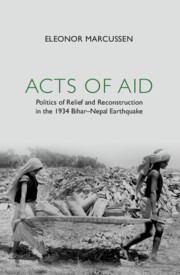Book contents
- Frontmatter
- Contents
- List of Illustrations
- List of Tables
- Acknowledgements
- List of Abbreviations
- Note on Transliteration
- 1 Introduction: Experiencing the Extraordinary and the Ordinary
- 2 Responses and Responsibilities in Emergency Relief
- 3 From Local to National Politics of Relief
- 4 Colonial Relations in Aid
- 5 Categories of Victims
- 6 Congested and Contested Spaces
- 7 Conclusion
- Glossary
- Bibliography
- Index
6 - Congested and Contested Spaces
Published online by Cambridge University Press: 13 January 2023
- Frontmatter
- Contents
- List of Illustrations
- List of Tables
- Acknowledgements
- List of Abbreviations
- Note on Transliteration
- 1 Introduction: Experiencing the Extraordinary and the Ordinary
- 2 Responses and Responsibilities in Emergency Relief
- 3 From Local to National Politics of Relief
- 4 Colonial Relations in Aid
- 5 Categories of Victims
- 6 Congested and Contested Spaces
- 7 Conclusion
- Glossary
- Bibliography
- Index
Summary
Introduction: Urban Renewal
The earthquake was, according to the local colonial government, administrators, engineers and segments of the population, an ideal scenario for rebuilding with better standards and for better socio-economic conditions. The devastation was effectively used to implement new town plans by arguing that reduced risk in future earthquakes could be achieved by changes in the plans of the bazaars. Conveniently, planning for earthquake-safe bazaars conflated with improvements of sanitary provisions and roads. In reply to an initial proposal for town planning in the larger towns of Muzaffarpur and Darbhanga, the Commissioner of Tirhut expressed his views regarding suggestions for town planning in Tirhut. The earthquake was an opportunity to transform Darbhanga into ‘the model town’: ‘Theoretically the clean-sweep made by the earthquake is the Godsent [sic] opportunity to replace dirt, discomfort, and irregularity, by the model town’. In Monghyr and Muzaffarpur, too, the rebuilding phase from 1934 to 1937 was viewed by the government and engineers as an opportunity for making changes in the social and material fabric of society, underlining the positive outcome of the earthquake as a form of creative destruction. The transformative aspect of disasters is a recurrent theme in urban history. As suggested in the case of North American disasters, to rebuild better after disasters is an integral part of a capitalist system which feeds on disasters and upheavals. In its most extreme form, disaster research has compared the phenomenon of reconstruction after disasters to a phoenix rising from the ashes. The Great Fire of London in 1666 is often taken as an example of changes in architecture and construction types as a result of large-scale destruction. In a long-term perspective, particularly important since seismic events may have long intervals in between, the question is to what extent the disaster provides lessons learnt with future events in consideration. Japan is one such example where construction materials and methods for building earthquake-resistant buildings evolved through experiences with major catastrophes. But also when there is learning from a disaster, several other variables such as public facilities, transport routes and access to water play a major role in urban reconstruction.
Information
- Type
- Chapter
- Information
- Acts of AidPolitics of Relief and Reconstruction in the 1934 Bihar–Nepal Earthquake, pp. 248 - 301Publisher: Cambridge University PressPrint publication year: 2023
- Creative Commons
- This content is Open Access and distributed under the terms of the Creative Commons Attribution licence CC-BY-NC 4.0 https://creativecommons.org/cclicenses/
